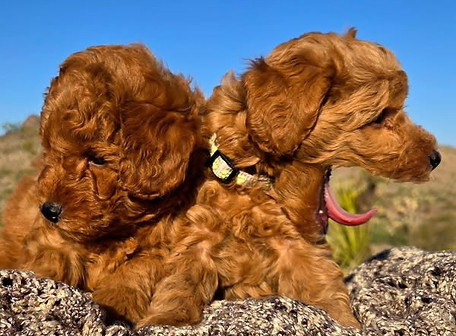
Colors and Patterns
Genetics Basics for Poodle Colors and Traits
Before diving into the amazing world of coat colors and patterns, it helps to understand a few key concepts about genetics. Don’t worry—it’s simpler than it sounds!
🔹 What Is a Locus?
-
A locus (plural: loci) is like a specific address or location on a chromosome.
-
Each locus holds genes that control a certain trait—like coat color, pattern, or texture.
-
Think of a locus like a mailbox for a particular genetic instruction—say, the K locus handles whether a dog is solid black or patterned.
🔹 What Is an Allele?
-
An allele is a version of a gene found at a specific locus.
-
Every dog has two alleles at each locus—one from their mom and one from their dad.
-
The combination of those two alleles is what determines how that trait shows up.
For example: At the B locus (which controls black or brown pigment), a dog might inherit a B from dad and a b from mom. Since B is dominant, the dog will appear black, even though it carries brown.
🧬 How Does Inheritance Work?
-
Each parent passes down one allele per locus to their puppies.
-
The combination the puppy gets from both parents creates their genotype (genetic makeup).
-
What we see—their coat color, pattern, or nose color—is their phenotype, which depends on how the alleles interact.
Some alleles are:
-
Dominant – Only one copy is needed to show the trait.
-
Recessive – Two copies (one from each parent) are needed for the trait to appear.
-
Incomplete or Co-dominant – A mix or blend of both alleles can be seen.
Example: A Simple Genetic Match
Let’s say you’re breeding two Miniature Poodles:
-
Mom has genotype E/e at the E locus (black pigment allowed).
-
Dad has genotype e/e (recessive red).
Each puppy has a 50% chance of getting E/e and a 50% chance of e/e:
-
E/e puppies will show black, brown, or other eumelanin-based colors.
-
e/e puppies will be red, apricot, or cream, regardless of other loci!
The Colorful Cascade
When you combine all the loci together—A, B, E, K, D, G, I, S, and more—it becomes a beautifully complex puzzle. Each locus builds on the next like layers in a painting, making every puppy a unique genetic masterpiece.























